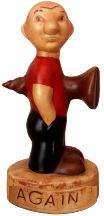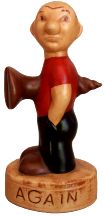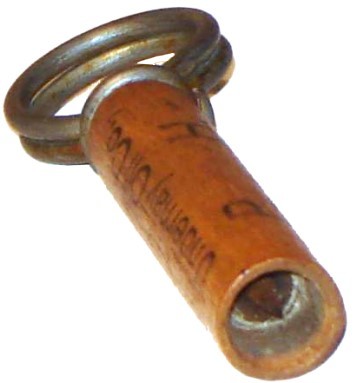 |
 The Virtual Corkscrew Museum's Weekly Newspaper |
 |
 |
 The Virtual Corkscrew Museum's Weekly Newspaper |
 |
|
Sunday, March 18, 2007 |
Got A Light?
After seeing the pipes and match boxes in the March 11 issue, reader Al Haché wrote "I find odd combinations both intriguing and fascinating e.g pipe and corkscrew, match box holder and corkscrew. Now, why put a corkscrew on a cigarette lighter? Here's one from my collection:"
Al got our curiosity up and we did a little research on the subject. We found a number of United States patents that included a corkscrew and a lighter. Here are four of them:
U. S. Patent No. 5,829,965 issued November 3, 1998 to Raul Rubalcava of Santa Ana, California for a Multifunction Waiter's Tool. Raul combined a bottle opener, a cigarette lighter, a bread crumb remover, and a corkscrew.
U. S. Patent No. 6,142,769 issued November 7, 2000 to Trevor Lee Walker of San Francisco, California. In discussing his patent, Walker suggests that previous inventions lacked certain elements for waiters to "accomplish a plurality of tasks". His Multi-purpose Tool invention offers "a serrated blade, a cork screw, a retractable pen, a refillable lighter, a bottle opener, and a flashlight".
U. S. Design Patent No. 452,037 issued December 11, 2001 to Andrew W. Smith of Pascoag, Rhode Island and assigned to Colibri Corporation, Providence, Rhode Island. Filed June 20, 2001.
Then along comes a group of guys who filed for a patent on May 29, 2001 and were granted U. S. Patent No. 7,125,145 on October 24, 2006 after over a five year wait. The inventors are from New York state and the patent was assigned to Taylor Cutlery of Kingsport, Tennessee. Their ultimate "survival tool" is designed to include such items as a mechanical compass, a multi-function electronic device with a digital watch with stopwatch and alarm, a digital compass, a digital thermometer, a digital barometer, a digital altimeter, a stud-finder, a global positioning system receiver, a range finder and calculator, a wireless telephone, a radio transmitter/transponder, a belt clip, a flashlight, a knife, a screwdriver, a saw blade a can opener, a corkscrew, a scissors, a lanyard coupling, and an opening adapted to fit a conventional disposable lighter. How can one live without it?
The idea of a corkscrew with lighter certainly isn't a late 19th Century idea. Here is an early German roundlet tool kit with lighter:

And here are a couple of French lighters with corkscrew and bottle cap lifter:
This corkscrew was given to members of the International Correspondence of Corkscrew Addicts on the 25th Anniversary of the group by Paolo DeSanctis, one of the ICCA founders:
Gallery of Modern Corkscrew Lighters
And, of course, one would expect a corkscrew - lighter combination in a Swiss Army Knife:
And for those who have had a ride on the Corkscrew Roller Coaster at Cedar Point, Sandusky, Ohio:

More Augustus Stephens Corkscrew Sheaths
by Mark Woodward
In the February 11, 2007 edition of The Weekly Screw, I reported finding an extant corkscrew based on Augustus W. Stephens' June 2, 1908 patent. The patent was entitled "Cigar Tip Perforator."
I recently received an email from Barry Taylor - he reports that he recently found another example of a Stephens sheath with Cigar Tip Perforator. Barry's example is clearly marked "A. W. Stephens Mfg. Co. Pat. June 2, 1908" and the sheath advertises "Capt. T. Mills Bottling Works, 220 Broad St. Waverly, N.Y."
I used the Google patent search engine to look for other patents issued to Augustus Stephens. Much to my surprise, I found two additional corkscrew sheath patents, # 982,893 and # 999,901.
Patent #982,893 for a "Bottle Cap Remover" was filed by Stephens on December 10, 1910 and issued to him on January 31, 1911. It looks remarkably similar to Clough's 1910 Decapitator, however upon close inspection one will see a slight variation. With Clough's Decapitator, the cap lifter was pinned directly to the wooden sheath. Stephens' improvement was to pin the cap lifter to a metal stud that was fitted into the butt end of the sheath. Stephens described his improvement as "an improved means for pivotally connecting the [lifting] dog with the holder in such a manner as to prevent liability of splitting the holder, which is usually made of wood, during the operation of removing a cap, and to prevent the dog from projecting outside the periphery of the holder when the device is carried in the pocket." Take a very close look at all of your "Decapitators" to see if you have a rare Stephens variation.
Stephens third (and final?) patent for a modified corkscrew sheath (patent #999,901) was filed on December 23, 1910 and issued on August 8, 1911. This was yet another variation on Rockwell W. Clough's idea of attaching a cap lifter to the end of a corkscrew sheath. Note that Stephens filed for both of these patents just months after Clough's Decapitator hit the market. This strongly suggests that Stephens and Clough were well aware of what the other was doing. Did Clough see Stephens as a competitor? Probably not. After all, for each sheath that Stephens produced, he needed to buy a wire corkscrew from Clough to fit into it. Clough probably viewed Stephens as a valued customer and their business relationship was most likely quite amicable.
Are there more examples of Stephens sheaths out there? Keep hunting and let us know what you find!
Editor's Note: Mark Woodard is an engineer with NASA based in Maryland. Mark is an avid corkscrew collector and is currently working on a book about the inventor of the crown cork (William Painter: Inventor and Industrialist).
Kurketrekker

De dood en zijn kurketrekker painted in 1982 by Dutch artist Anton Martineau.
|
©2007 Don Bull, Editor |